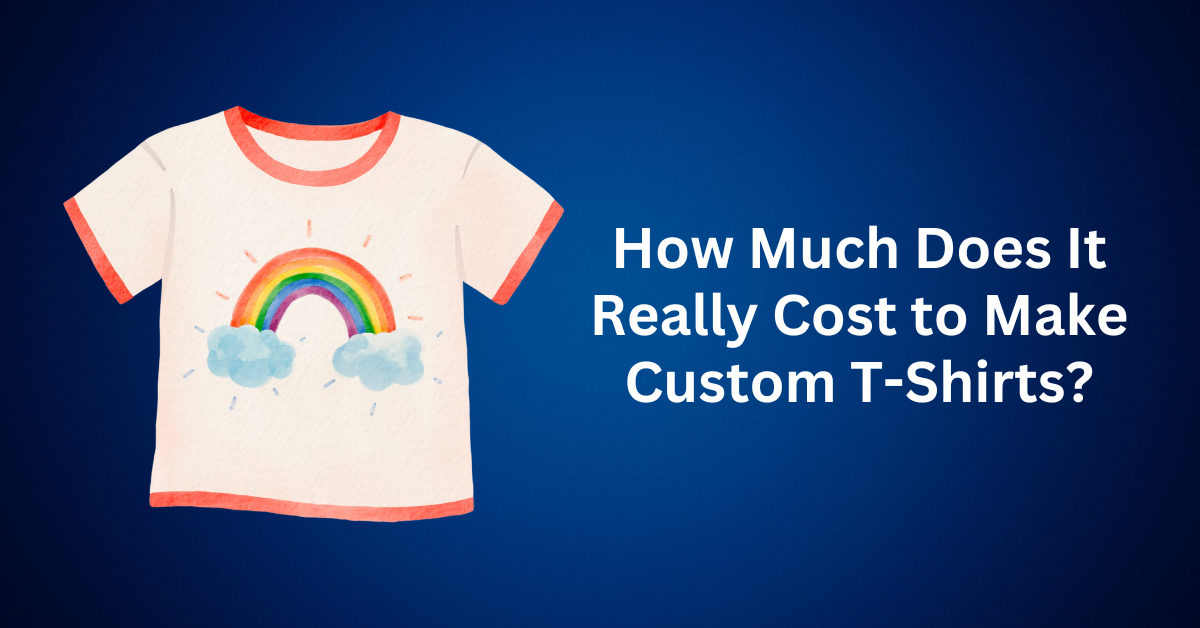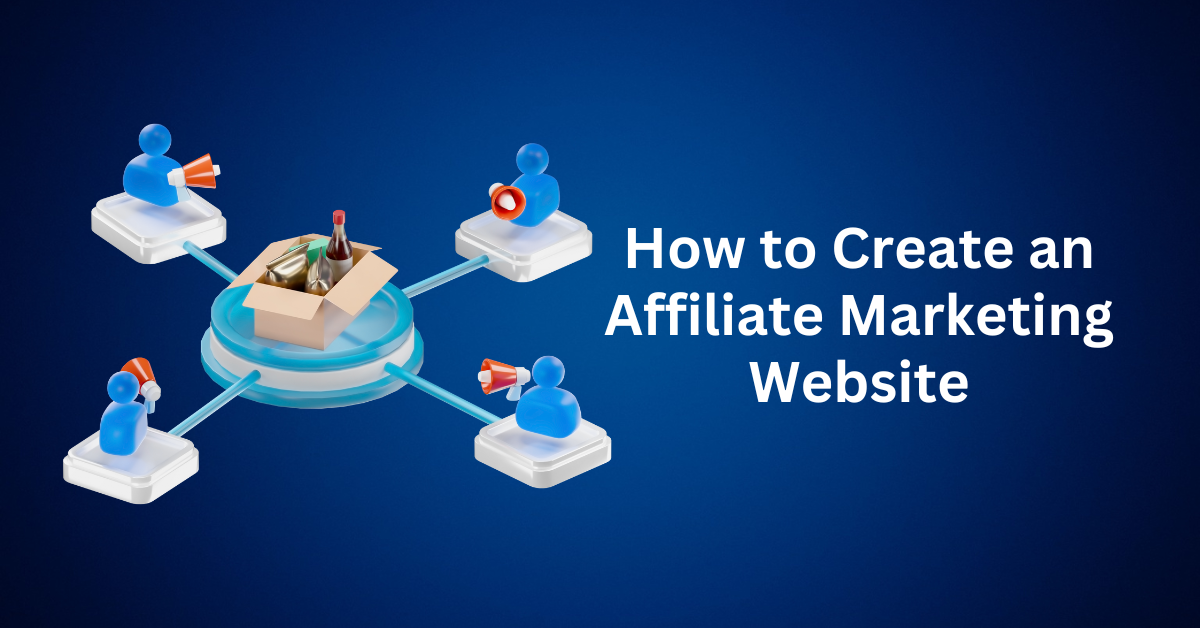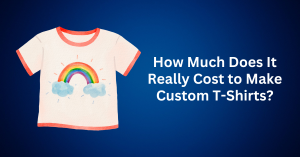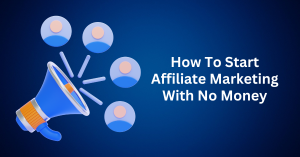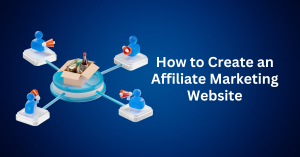The dropshipping business model is undeniably one of the best business models to start online. Projections suggest that the global dropshipping market will surpass $300 billion in 2024, and its growth trajectory remains robust. This presents an exciting opportunity for aspiring entrepreneurs looking to establish ecommerce ventures through dropshipping. However, with this expansion comes heightened competition from similar businesses. Embracing branded dropshipping not only bestows your brand with a distinct identity but also fosters a sense of reliability among your customers.
In this article, we’ll delve into the essence of branded dropshipping and explore the fundamentals of ecommerce dropshipping, along with practical insights on kickstarting your journey to selling branded products.
Start a Branded Dropshipping Store Today

Table of Contents
ToggleWhat is Branded Dropshipping?
Branded dropshipping is a low-risk, cost-effective business model that enables entrepreneurs to sell customized products under their brand without the burden of managing inventory. Instead of holding stock, you collaborate with third-party suppliers who handle everything from product fulfillment to packaging and shipping directly to customers. This arrangement allows you to concentrate on building a strong brand identity and executing effective marketing strategies.
One of the key advantages of branded dropshipping is that it allows you to offer a personalized and premium shopping experience. By customizing products with your brand’s logo, colours, and packaging, you create a distinct identity that differentiates your e-commerce store from generic dropshipping businesses. Consequently, this personalized touch helps in building a loyal customer base that recognizes and trusts your brand. Additionally, the unique branding fosters a sense of exclusivity, further enhancing customer loyalty and satisfaction.
Furthermore, branded dropshipping eliminates the significant upfront costs and risks associated with purchasing and storing inventory. Since you only pay for products when you receive orders, you can start your business with minimal financial investment and scale it more easily as demand grows.
The focus on branding and customer experience also means you can potentially charge higher prices compared to non-branded products, increasing your profit margins. With a well-defined brand and a strong online presence, your ecommerce business is more likely to attract repeat customers and generate long-term success.
How To Start a Branded Dropshipping Business?
1. Pick Your Branded Dropshipping Niche
Before you start anything, it’s crucial to define your product niche. This niche will significantly influence how you portray your brand. This includes the selection of text fonts and colours to the language style, and the overall unboxing experience.
Understanding your niche is vital because it helps you cater to a specific group of people who are looking for something unique and distinct. If your product designs cater to the preferences of a particular demographic, you will cultivate a higher level of loyalty among your customers. People who seek out niche brands are often looking for a distinctive look and feel that they resonate with, something they can’t easily find in the broader market. By identifying and defining your niche, you can more effectively locate your target audience. Alternatively, you can start by defining your target audience first to gain a better understanding of which dropshipping niche you should focus on.
To do this, you can identify your target audience profile. You might want to start with a narrow niche to build a strong, loyal customer base. Over time, you can gradually expand to appeal to a larger pool of potential customers.
By defining your niche, you establish a solid foundation for your design approach, including aspects like product packaging. Thoughtful design choices can significantly enhance the customer experience. It’s the small, thoughtful details that often make the biggest impact and go a long way in building lasting customer loyalty.
Start a Branded Dropshipping Store Today
2. Create Your Branded Dropshipping Identity
Effective branding for e-commerce companies goes beyond having an internationally recognized logo. It is deeply rooted in values and a distinct brand voice, which permeates every aspect of the business, from the website and social media presence to packaging and includes freebies like stickers.
The journey to impactful branding starts with crafting a robust brand identity, which acts as a beautifully packaged promise of quality and trustworthiness. This identity is instrumental in fostering positive customer relationships, essential for encouraging repeat business. If customers walk away with neutral or negative impressions, it becomes significantly harder to win them back.
Your Brand’s Purpose
The foundation of your brand is its purpose—the core reason your business exists. While you might be clear on this, it’s crucial that your target audience understands it too. Clearly defining your brand’s purpose is especially valuable for companies committed to specific causes or values.
By articulating this purpose through a compelling brand story, you build trust, enhance customer loyalty, and inspire engagement. Additionally, a well-defined purpose provides a clearer framework for the operational strategies that will guide your business toward success. It highlights what sets your products apart from competitors, significantly boosting your marketing efforts.
The goal is to communicate the direction your business is heading and its long-term vision. This narrative can be shared on your website and integrated into various elements such as content copywriting, packaging, and design.
Your Brand’s Values
Strong values are central to an effective branding strategy. They resonate with your audience and foster customer loyalty. Statistics show that a majority of US consumers prefer shopping with companies that align with their values. Loyal customers are more likely to recommend your business to others, effectively becoming advocates for your brand without being on your payroll.
According to Forbes contributor Kimberly Whitler, word-of-mouth marketing is potentially the most valuable form of marketing, as consumers trust it more than any other form.
Your Brand Voice
Your brand voice is the embodiment of your core message to your target audience, expressed in a style of language that resonates with them. Aim for a tone that is friendly and familiar, making your audience feel there is a person behind the brand they can relate to. People naturally gravitate towards what feels familiar.
When customers encounter your brand, there should be an emotional connection. We connect with entities that understand us, and brands can cultivate this feeling of connection by becoming the physical expression of their customers’ personalities. Ensure that your brand voice sparks these connections and emotions, making it an integral part of the customer experience.
By focusing on purpose, values, and voice, you can create a cohesive and compelling brand that not only attracts customers but also keeps them coming back.
3. Choose Your Branded Dropshipping Supplier
Once you’ve identified your niche and established your brand identity, the next step is selecting the right dropshipping supplier. The supplier you choose will significantly impact your product quality, shipping times, and overall customer satisfaction.
Reputation
Before deciding on which supplier, you need to research its reputation. You can look for reviews and testimonials from other dropshippers. Reliable suppliers will have a positive track record of fulfilling customer orders on time and providing high-quality products. Hence, start with customer reviews and ratings to gauge the supplier’s reputation.
Product Quality
Before finalizing a supplier, order samples of the products you plan to sell. This step allows you to verify the quality of the products and ensure they match the descriptions and images provided by the supplier. High-quality products result in fewer returns and higher customer satisfaction, which is essential for building a strong brand.
Besides, by ordering samples, you can feel the overall fulfillment process. This is important to ensure your customer satisfaction.
Shipping
Shipping speed is crucial for customer experience and satisfaction. You need to confirm the average shipping times to your target markets. As different countries and suppliers’ locations will affect the shipping cost and time, be cautious when selecting your suppliers.
Suppliers with long shipping times can lead to dissatisfied customers and negative reviews. Hence, efficient and timely shipping is vital for maintaining a positive customer experience.
Customer Support
Next, test the supplier’s responsiveness by asking questions to their customer support. Ideally, a reliable supplier should respond promptly and provide clear, helpful answers. It will be a plus point if they can provide 24/7 customer support. Good communication ensures that any issues can be quickly resolved and that you can keep your customers informed throughout the process.
Return Policy
Meanwhile, you need to understand the supplier’s return and refund policies thoroughly. A flexible return policy will help you manage customer returns and maintain satisfaction. With this, you can ensure the supplier can handle returns efficiently and that their return process aligns with your business model.
Branding Options
Since you’re on branded dropshipping, you need to make sure that the supplier can have custom branding for your products. This will include custom packaging, labels, and other branding materials. This capability is essential for maintaining brand consistency and enhancing the overall customer experience.
By carefully considering these factors—reputation, product quality, shipping, customer support, return policy, and branding options—you can choose a dropshipping supplier that will support your business’s growth and help you deliver a superior customer experience.
4. Choose A Product Line For Your Branded Dropshipping Business
Once you’ve researched suppliers and know your options, it’s time to start creating a product line that resonates with your niche. Here’s how to proceed:
Select Products That Align with Your Niche
Choose products that fit seamlessly within your niche. For example, if you specialize in fitness apparel, consider items such as leggings, sports bras, and tank tops. These products should reflect your brand identity and appeal to your target audience.
Test a Few Items First
Before committing to a full product line, start by testing a few items. This is where print-on-demand services are especially beneficial. They allow you to experiment with different products and designs without any upfront investment. This approach helps you identify which products resonate most with your customers.
Order Product Samples
To ensure the quality of your products and the accuracy of your designs, order samples. This step allows you to verify that everything meets your standards and lets you experience the unboxing process firsthand. Quality control is crucial for maintaining customer satisfaction and building a reputable brand.
Gather and Analyze Customer Feedback
As you launch your initial products, pay close attention to customer feedback. Track what sells best and what receives the most positive responses. This feedback is invaluable for refining your product line, enabling you to focus on trending products that your customers love.
Steps to Optimize Your Product Line
Firstly, start small by introducing a limited range of products to test the market response. This approach allows you to manage risk and gather valuable insights without overcommitting resources.
Then, monitor performance closely using analytics to track sales, customer reviews, and feedback. This data will help you understand how well your products are received and identify any areas for improvement.
This is followed by refining your selection based on the data you collect. You need to adjust your product offerings to focus more on what sells well and reduce or eliminate products that don’t perform as expected. This will help optimize your inventory and meet customer demand more effectively.
In the meantime, expand gradually once you have a clear understanding of your best-sellers. Introduce complementary items to your product line to offer a more comprehensive selection and enhance customer satisfaction.
Finally, you should stay updated with market trends and continuously seek customer feedback to remain relevant and responsive to evolving demands. This proactive approach will ensure your product line stays fresh and appealing to your target audience.
By following these steps, you can effectively develop a product line that not only fits your niche but also meets your customers’ needs and preferences, setting the foundation for a successful e-commerce business.
Start a Branded Dropshipping Store Today
5. Select A Sales Channel for Your Branded Dropshipping Business
The next step is to strategize how you’ll connect with your customers. The sales channels you select for your business will significantly influence how you engage with customers, manage your store, and handle transactions. Here’s a comprehensive guide to help you make the best choice for your business.
First, you need to decide whether to use an e-commerce platform or a marketplace.
E-commerce Platforms
Opting for e-commerce platforms like Shopify or WooCommerce gives you full control over your dropshipping store. These platforms allow you to customize every aspect of your website, ensuring it aligns perfectly with your brand identity. You can enhance your brand presence with custom domain names, personalized email addresses, and integrated marketing tools. This level of control enables you to create a unique shopping experience tailored to your target audience.
Additionally, e-commerce platforms often provide robust analytics and reporting features, helping you track performance and make data-driven decisions.
Marketplaces
On the other hand, marketplaces such as Amazon and Etsy come with a built-in customer base. This can be a significant advantage for reaching a broad audience quickly. These platforms handle critical aspects of the business, such as payment processing and customer service, allowing you to focus more on product sourcing and branding.
However, they typically offer less control over your branding and customer experience. Marketplaces also come with their own set of rules and regulations that you must adhere to, which can sometimes limit your flexibility.
Cost Considerations
When choosing between an e-commerce platform and a marketplace, it’s crucial to consider the associated costs. These may include monthly subscription fees, transaction fees, and additional charges for premium features.
E-commerce platforms often have a tiered pricing model. They will allow you to choose a plan that fits your budget and needs. Marketplaces, on the other hand, might charge listing fees or take a commission on each sale. Be sure to factor these costs into your budget to ensure your online business remains profitable.
In summary, the decision between an e-commerce platform and a marketplace will depend on your business goals, budget, and the level of control you wish to maintain over your store.
6. Showcase Your Brand Identity
Showcasing your brand identity is your chance to make a first impression and tell your story. Whether through your website, logo, colour scheme, or other branding elements, creating a cohesive and engaging brand presence will set you apart from the competition and help build a loyal customer base.
Website
Your website is the digital storefront and narrative hub for your brand. It’s not just a product catalog but a storybook where you can set the stage and convey your brand voice. A sleek, trendy web user interface is excellent for many businesses, but for certain niches, thinking outside the box can be more effective.
In addition, you can incorporate elements that reflect your brand’s personality and values, ensuring that every page resonates with your audience. The design should be intuitive and visually appealing, making it easy for visitors to navigate and engage with your content.
Logo
Your logo is a cornerstone of your brand identity. A typographic logo can express your brand’s character. Hence, creating associations such as timelessness, playfulness, or exclusivity. These logotypes are effective for brand recognition and are particularly useful for new businesses. However, be mindful that typographic logos can be tricky—they can convey trust and professionalism or, if poorly designed, lead to confusion and appear amateurish.
On the other hand, icons or symbol logos can increase the perceived quality of your products. Such logos suggest good craftsmanship and luxury, making a significant impact as your business grows.
Colours
Colour plays a vital role in how customers perceive your brand. Think about the emotions you want to evoke when customers encounter your brand and use colors to enhance these feelings. Choosing the right colour schemes is crucial in adding a solid vibe to your brand’s overall look.
While your colour choices don’t necessarily have to align perfectly with your brand’s message and niche, doing so helps create a more cohesive brand image in your customers’ minds. You can create your colour palette or explore popular ones on platforms like Color Hunt. This tool can also be valuable for product photography or mockup designs, ensuring a consistent and appealing visual identity across all your branding materials.
Labels
Product labels are foundational elements of branding for an online clothing store. Custom labels are a powerful way to demonstrate that your business takes its image seriously. These labels not only help differentiate your garments from those of other similar dropshipping businesses but also serve as a subtle reminder to customers of where their products originated.
Custom labels can enhance the perceived value of your clothing, reinforcing the quality and craftsmanship of your brand. They can include not just your logo, but also other information such as care instructions, materials used, and even a brief brand story. This attention to detail helps build trust and loyalty, making your brand more memorable and encouraging repeat business.
Packaging
Branded packaging is a highly effective way to distinguish your brand from competitors and leave a lasting impression on your customers. Packaging is not just about protecting the product. Instead, it’s an extension of your brand’s identity and a crucial touchpoint in the customer experience. The moment a customer receives and opens your package is their first physical interaction with your brand, and this first impression is vital.
Humans are inherently visual creatures, processing much of the information based on what we see. The visuals of your packaging—such as size, shape, colour palette, and imagery—convey meanings and create associations in the minds of your customers. Thoughtfully designed packaging can communicate your brand’s values, product messaging, and level of quality. For example, eco-friendly packaging can emphasize a commitment to sustainability, while luxurious, well-crafted packaging can enhance the perception of premium quality.
Packaging Inserts
Your packaging is a powerful marketing tool for your brand. However, if you want to take it to the next level, packaging inserts are the perfect addition. These small additions serve as opportunities to establish a personal connection with your customers and enhance their overall experience.
Here’s how packaging inserts elevate your brand:
- Greeting or Thank You Note: A simple but heartfelt message expressing gratitude can go a long way in making your customers feel appreciated and valued.
- Personalized Note: Take it a step further by including a personalized note addressing the customer by name or referencing their purchase. This personal touch adds warmth and sincerity to your brand communication.
- Coupon Code for Next Purchase: Encourage repeat business by offering a discount or special offer for their next purchase. This not only incentivizes future sales but also shows appreciation for their loyalty.
- Brand Purpose or Goals: Share information about your brand’s mission, values, or sustainability efforts. Educating customers about your brand’s ethos can create a deeper connection and foster brand loyalty.
- Sustainability Effort Info Card: If sustainability is a core value of your brand, include an informational card detailing your eco-friendly practices and initiatives. This reinforces your commitment to sustainability and may resonate with environmentally conscious customers.
- Small Gifts or Sticker Freebies: Surprise and delight your customers with a small gift, such as branded stickers or samples. These unexpected extras leave a positive impression and encourage brand advocacy.
- Request for Social Media Sharing: Encourage customers to share their unboxing experience or photos of their purchase on social media with a branded hashtag. User-generated content can amplify your brand’s visibility and attract new customers.
Start a Branded Dropshipping Store Today
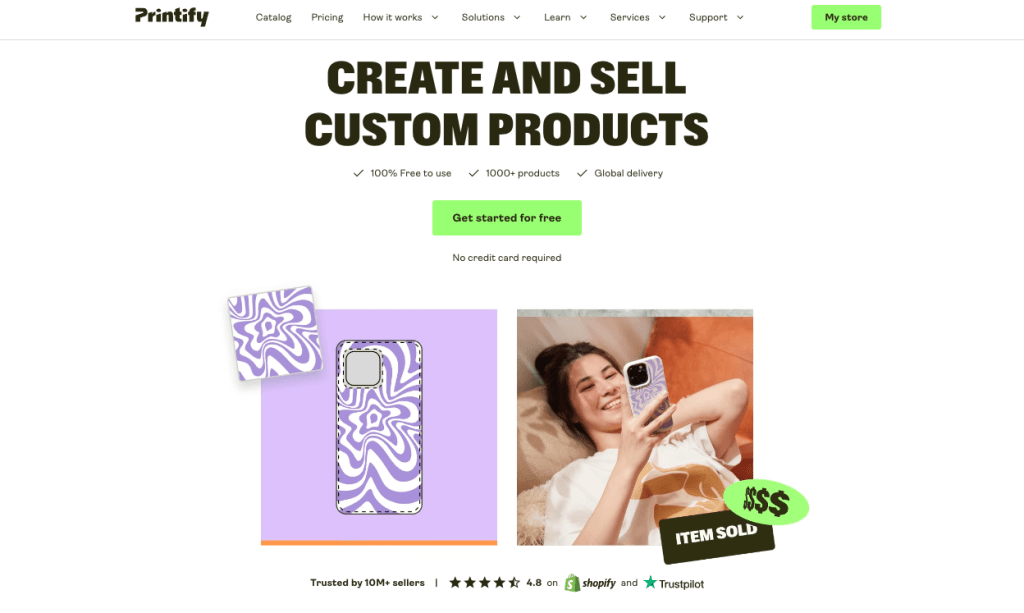
7. Custom Branding with Printify
Adding custom branding with Printify is a fantastic way to elevate your brand and create a memorable experience for your customers. Here’s a step-by-step guide to help you navigate the process:
- Create Your Printify Account: If you haven’t already, start by signing up for a Printify account. It’s free to join, and you’ll gain access to a wide range of print-on-demand products.
- Choose Your Products: Browse through Printify’s extensive catalog of products and select the items you want to customize with your branding. From apparel and accessories to home decor and stationery, there’s something for every niche.
- Upload Your Designs: Before adding custom branding, you’ll need to upload your designs to the Printify platform. Make sure your designs meet the printing partner’s specifications in terms of file format, size, and resolution for optimal printing results.
- Add Your Branding Elements: Now it’s time to add your branding elements to the products. This can include your logo, brand name, tagline, or any other branding elements you want to incorporate. Printify offers options for adding custom labels, packaging inserts, and other branding elements to create a cohesive brand experience for your customers.
- Preview and Review: Before finalizing your order, take advantage of Printify’s preview feature to see how your custom branding will look on the products. Review each item carefully to ensure everything is aligned and looks as you envisioned.
By following these steps, you can seamlessly add custom branding to your products with Printify, enhancing your brand’s visibility and creating a unique and memorable experience for your customers.
Custom Branding Options with Printify
Custom branding with Printify offers a variety of options to help you create a unique and memorable brand experience for your customers. Here’s a detailed breakdown of the different custom branding options available:
1. Custom Labels
Printify allows you to add custom labels to your products, giving them a professional and branded touch. These labels can feature your logo, brand name, care instructions, or any other information you want to include. You can choose from a range of label types, including woven labels, satin labels, and printed labels, to suit your branding needs.
2. Packaging Inserts
Packaging inserts, also known as pack-ins, are additional items included in your product packaging to enhance the unboxing experience. With Printify, you can add personalized notes, thank-you cards, coupons, or promotional materials to your packages. These inserts help build a personal connection with your customers and can encourage repeat business and word-of-mouth marketing.
3. Branded Packaging
Branded packaging is a powerful way to reinforce your brand identity and make a memorable impression on your customers. Printify offers options for customizing your packaging with your logo, brand colours, and other branding elements. You can choose from various packaging materials and styles, including poly mailers, boxes, and tissue paper, to create a cohesive and eye-catching packaging design that reflects your brand’s personality.
4. Hang Tags
Hang tags are another branding option available through Printify. These tags can be attached to your products to provide additional branding and product information. You can customize hang tags with your logo, brand name, product details, and pricing, adding a professional finishing touch to your products.
5. Stickers and Decals
Stickers and decals are versatile branding tools that can be used in various ways. Printify offers options for customizing stickers and decals with your logo, brand colours, and other graphics. These can be used as promotional giveaways, packaging seals, or product enhancements to further reinforce your brand identity.
6. Branded Apparel
In addition to branding your packaging and promotional materials, Printify also allows you to create custom-branded apparel for your brand. You can add your logo, brand name, or other designs to a wide range of clothing items, including T-shirts, hoodies, hats, and more. This enables you to create a cohesive and recognizable brand image across all your products.
By leveraging these different custom branding options with Printify, you can create a strong and consistent brand identity that resonates with your target audience and sets you apart from the competition. Whether through custom labels, packaging inserts, branded packaging, or other branding elements, Printify provides the tools you need to make your brand stand out and leave a lasting impression on your customers.
8. Marketing For Your Branded Dropshipping Business
Advertising your branded dropshipping business is crucial for attracting customers and driving sales. Here’s a comprehensive guide to crafting a compelling advertising strategy that highlights your brand identity and resonates with your target audience across various channels:
Social Media Marketing For Your Branded Dropshipping Business
Utilize platforms like Facebook, Instagram, and TikTok to showcase your products through engaging visuals and stories. Tailor your content to each platform’s strengths; for instance, Instagram is perfect for visually appealing ads, while Facebook offers detailed targeting options. Ensure your ads incorporate consistent branding elements such as your logo, colours, and fonts to reinforce brand recognition.
Search Engine Advertising For Your Branded Dropshipping Business
Harness the power of platforms like Google Ads to reach customers actively searching for products like yours. Craft targeted ads with relevant keywords and compelling copy that highlights your product’s benefits and features. Optimize your ads to drive clicks and conversions, leveraging Google’s vast reach and precise targeting capabilities.
Email Marketing For Your Branded Dropshipping Business
Email remains one of the most effective ways to engage customers. You can incentivize new subscribers with discounts or free shipping and send regular newsletters with updates, promotions, and personalized recommendations. Besides, you need to ensure that your emails are visually appealing and aligned with your brand identity. Personalize content to address recipients by name and offer tailored suggestions to boost engagement and conversion rates.
Content Marketing For Your Branded Dropshipping Business
Create valuable content such as blog posts, how-to guides, and product reviews to attract and retain customers. For instance, if you sell fitness apparel, publish blog posts about workout tips and fitness routines. Share this content on your website and social media channels to drive traffic and build trust with your audience.
Promotions and Discounts For Your Branded Dropshipping Business
Who doesn’t love a bargain? Offering promotions and discounts is a surefire way to captivate new customers while nurturing loyalty among existing ones. But it’s not just about slashing prices; it’s about crafting enticing offers that resonate with your audience.
- Tailored Promotions: Understand your target demographic and tailor your promotions to their preferences. Whether it’s a percentage discount, a buy-one-get-one-free deal, or a limited-time offer, make sure it aligns with what your customers value most.
- Create Urgency: Time-limited offers and flash sales inject a sense of urgency, compelling customers to act quickly. Consider running exclusive discounts for email subscribers or social media followers to reward their loyalty and make them feel special.
- Multichannel Promotion: Spread the word far and wide by promoting your deals across all channels. From your website banners to social media posts and email newsletters, ensure consistent messaging to reach customers wherever they are.
- Engage with Storytelling: Don’t just announce your promotions; tell a story around them. Highlight the benefits of your products or services and how the discount enhances the value proposition. Engaging narratives can make your promotions more memorable and shareable.
- Incentivize Referrals: Encourage word-of-mouth marketing by offering referral discounts. When satisfied customers share their positive experiences with friends and family, everyone wins.
Measurement and Optimization For Your Branded Dropshipping Business
Launching promotions is only half the battle; the real magic happens when you refine your strategies based on data-driven insights.
- Comprehensive Analytics: To measure the performance of your advertising campaigns, start by leveraging analytics tools. By tracking key metrics such as click-through rates, conversion rates, and return on ad spend, you can accurately gauge their effectiveness and make data-driven decisions.
- A/B Testing: Experiment with different promotion formats, messaging, and channels through A/B testing. This empirical approach allows you to identify what resonates best with your audience and refine your tactics accordingly.
- Customer Feedback: In addition, never underestimate the value of direct customer input. By conducting surveys or social media polls, you can gain valuable insights into their preferences and pain points, which in turn will help shape your marketing approach.
- Continuous Optimization: Finally, remember that optimization is not a one-time task but an ongoing process. By regularly reviewing your advertising efforts, pinpointing areas for improvement, and implementing changes, you can continuously enhance performance and maximize ROI.
Final Thoughts: Step-by-Step Guide To Start Your Branded Dropshipping Business
Crafting a brand for your business may seem daunting, but with the support of a dropshipping partner such as Printful, the process becomes significantly more manageable than tackling it solo. Remember to stay aligned with your objectives and principles. Establishing a meaningful brand requires careful consideration—it’s a journey akin to building Rome, not a quick task.
Developing a brand with substance takes time, so start small and take gradual steps. Enhance your logo, consider custom labels, or create appealing mailers, and test them within a targeted shipping area. Have faith that the effort invested will yield significant rewards.


